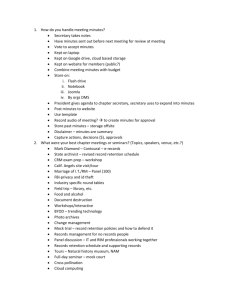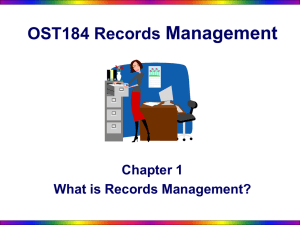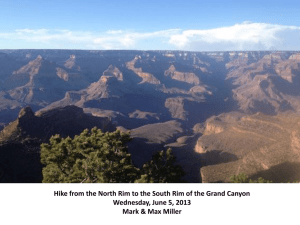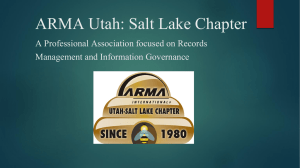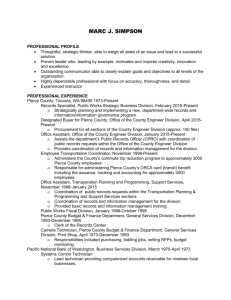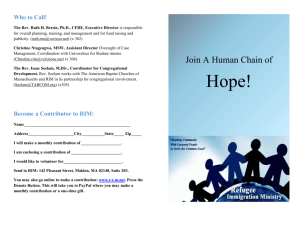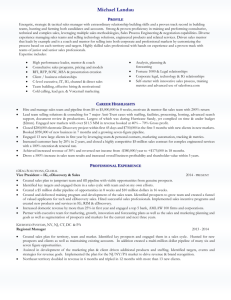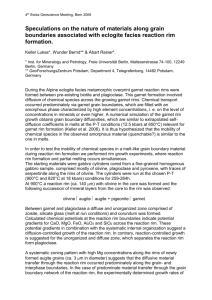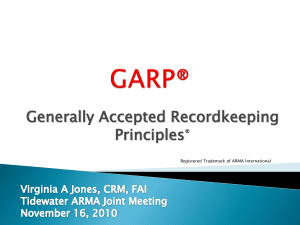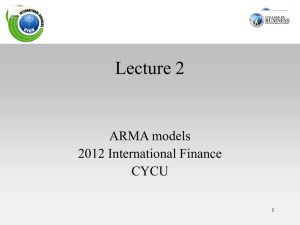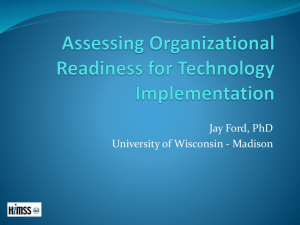September 15, 2014 – Applying The Principles to Establish a
advertisement
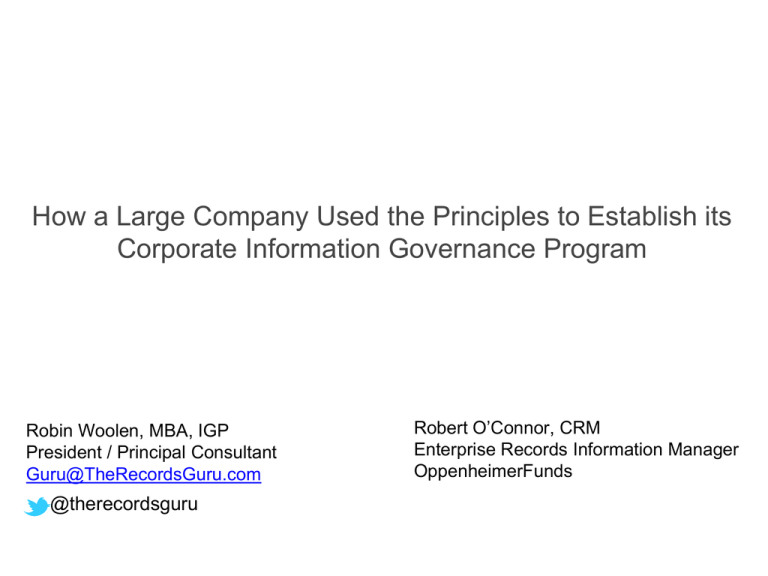
How a Large Company Used the Principles to Establish its Corporate Information Governance Program Robin Woolen, MBA, IGP President / Principal Consultant Guru@TheRecordsGuru.com @therecordsguru Robert O’Connor, CRM Enterprise Records Information Manager OppenheimerFunds Learning Objectives • Leverage The Principles to establish the core competency of the records management program with Management. • Utilize The Principles Assessment process as a basis for strategic planning and chart progress. • Outline your core objectives for your RIM program. • Apply the Generally Accepted Recordkeeping Principles to your business process The Premise • International Engineering, Construction and Mining company in the United States • 100+ Years old • 70+ Offices across United States, Canada and Australia • Mainly through merger and acquisition • 10,000 + Employees • No enterprise-wide Records Management program • Steering Committee pushed to have one established • Records Manager hired to create program from scratch What are The Principles? The Principles refer to the Generally Accepted Recordkeeping Principles® established by ARMA International to set forth the characteristics of an effective recordkeeping program, while allowing flexibility based upon the unique circumstances of an organization’s size, sophistication, legal environment, or resources. Hint: Use the ARMA reputation as the International Standard for Records Management programs with Executives to establish authority and gain acceptance. The Principles: Your Sword & Shield The Process • • • • • Evaluate Analyze Strategic Planning Implement Validate The Process: Evaluate • Tools • ARMA International Maturity Model for Information Governance • The Principles Checkup • New from ARMA • Focused from the Records Manager perspective • Records Manager may not have all the info Get out and talk to people! The Process: Evaluate • • Tools • ARMA International Maturity Model for Information Governance • The Principles Checkup • New from ARMA • Focused from the Records Manager perspective • Records Manager may not have all the info Process • Meet with stakeholders to gain complete picture of current situation • Management • IT • Operational Staff • Evaluate each functional area and office individually Get out and talk to people! The Process: Evaluate • ARMA International Maturity Model for Information Governance • Used as scorecard • 40 is a perfect score The Process: Evaluate • Accountability • Is there someone of authority actively involved in ensuring the RIM program is being followed? The Process: Evaluate • • Accountability • Is there someone of authority actively involved in ensuring the RIM program is being followed? Transparency • Is the RIM program documented and easily available for reference by everyone involved? • Are established information lifecycle processes open and verifiable? The Process: Evaluate • • • Accountability • Is there someone of authority actively involved in ensuring the RIM program is being followed? Transparency • Is the RIM program documented and easily available for reference by everyone involved? • Are established information lifecycle processes open and verifiable? Integrity • Is the RIM program designed to promote a reasonable expectation that what is available is the one version of truth? • Has metadata been preserved? The Process: Evaluate • • • • Accountability • Is there someone of authority actively involved in ensuring the RIM program is being followed? Transparency • Is the RIM program documented and easily available for reference by everyone involved? • Are established information lifecycle processes open and verifiable? Integrity • Is the RIM program designed to promote a reasonable expectation that what is available is the one version of truth? • Has metadata been preserved? Protection • Is the RIM program designed to ensure the appropriate security of information based on regulatory or operational needs? The Process: Evaluate • Compliance • Is the RIM program designed to comply with all legal and regulatory needs? The Process: Evaluate • • Compliance • Is the RIM program designed to comply with all legal and regulatory needs? Availability • Is the information easily and quickly accessible? The Process: Evaluate • • • Compliance • Is the RIM program designed to comply with all legal and regulatory needs? Availability • Is the information easily and quickly accessible? Retention • Is there a documented retention schedule that meets all legal, regulatory and operational needs? The Process: Evaluate • • • • Compliance • Is the RIM program designed to comply with all legal and regulatory needs? Availability • Is the information easily and quickly accessible? Retention • Is there a documented retention schedule that meets all legal, regulatory and operational needs? Disposition • Is the retention schedule followed and documented? The Process: Analyze • • • • • • Review results with Stakeholder(s) What’s the score? • ARMA International Maturity Model for Information Governance • The Principles Checkup Find the gaps • Use the tools to highlight target areas. Risk analysis • Which target area(s) are the most critical? ROI analysis • Which target area(s) offer the best return for available budget? Create list of target area(s) based on analysis The Process: Strategic Planning • Use list to create a strategic plan with Stakeholders (Steering Committee) • Short term • What is the cheapest/easiest/quickest to implement from the list? • Generally process changes • Go for the “Low-hanging Fruit” to get a “Quick Win” • Build reputation and awareness • Work your way up the list The Process: Strategic Planning • Use list to create a strategic plan with Stakeholders (Steering Committee) • Short term • What is the cheapest/easiest/quickest to implement from the list? • Generally process changes • Go for the “Low-hanging Fruit” to get a “Quick Win” • Build reputation and awareness • Work your way up the list • Long term • More expensive changes • Electronic Document Management Systems • Records Center development/moves • Use phased approach over time The Process: Implement • • • • • • • • Follow standard methodology Budgetary Process Staffing Plan • Point person in each functional area Key Stakeholders • IT - Early integration with Key IT Leadership critical • Legal - Find your Legal sponsor ASAP • Compliance - Should be one of biggest supporters • Operations - Business support is essential Schedule/Project Plan Communication/Change Management Plan Training Plan • Curriculum • Materials Support Plan The Process: Validate • • Tools • ARMA International Maturity Model for Information Governance • Documented Annual training • Continual Communication • Survey • Metrics Process • Regular Staff Assist Visits • Include as part of annual audit • Meet with stakeholders to gain complete picture of current situation • Evaluate each functional area and office individually • Compare to last result to show trend and identify deficiencies The Results: Short/Long Term • Final Project Result • An EDMS was identified for all business processes • Automated processes were established for archiving and disposal. • A centrally managed Record’s repository was established on premise. • Central oversight control established for all physical records. The Results: Short/Long Term • • Final Project Result • An EDMS was identified for all business processes • Automated processes were established for archiving and disposal. • A centrally managed Record’s repository was established on premise. • Central oversight control established for all physical records. Unforeseen Awareness Items • Reduced Executive support for RIM Program • Lesson learned - Must continually engage with Management to maintain relevance in the budgetary/political process of the company. References • • • • ARMA International Generally Accepted Recordkeeping Principles University of Oregon: Applied Information Management Records Management Best Practices Guide The Records Guru® Questions? Robin Woolen, MBA, IGP President / Principal Consultant Guru@TheRecordsGuru.com @therecordsguru Robert O’Connor, CRM Enterprise Records Information Manager Oppenheimer Funds Compliance Dept.
